A Paipo Interview with Peter White
Interview February 28 and phone interview January 29, 2012 - Mermaid
Beach, Australia
Questions by Bob Green
After living next door to Val Valentine at Sunset Beach, Peter White returned
to New Zealand and made a mould to produce paipo boards like Val Valentine's, which were
based on a design developed by John Waidelich and Jim Growney (see The Paipo Interviews). Peter
rode his boards all around New Zealand, however, it was at Muriwai that
a group of surfers based around the local life saving club continued to
ride these paipos.
|
1. I'd heard you did a trip to
Hawaii - what year was that?
It was in 1963. I've got a newspaper
clipping.
New Zealand newspaper paipo surfing article featuring Peter White and a photo included in the 1967 article.
|

|
|
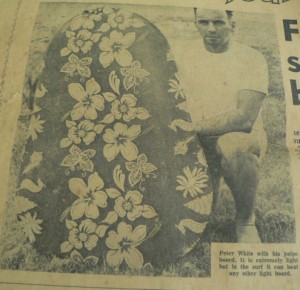
|
Flett, Neil. (1967, January 28). For speed in the surf, you can't beat a paipo. Auckland Star,
p. 38. This article appeared in the newspaper section "At you leisure."
Article and photo scan courtesy of E. Bishop, Central Auckland Research
Centre Auckland Libraries - Nga Whare Matauranga o Tamaki Makaura and
Peter White. Peter White provided the figure on the right.
|
2. Text from the article in its entirety plus White's photographs that were included in the article:
About halfway between
the exhilaration of
bodyshooting and the thrill of surf riding comes the newer surf-sport of
paipo-boarding. The man who brought the boards to New Zealand is Peter
White, of Onehunga.
A Muriwai lifesaver, he discovered the paipo boards while he was
staying at Sunset Beach, Hawaii, in 1963.
The 3ft by 2ft, 6in' plywood and fiberglass "saucers" could outrun, the
fastest surfboards in the 10 to 20ft waves.
Once he tried them he discarded his six years of board riding and bought
a paipo.
"The big gun surfboards in Hawaii do more than 30 miles an hour down a
wave, and yet the paipo riders just flashed past", he said.
He recalls seeing paipo board riders skimming across waves with their
faces only inches from the wall.
"The paipos could do more than 40 miles an hour in the huge Sunset
surf," he said.
The boards are really a variation of the old ironing board, but
where they differ they do so greatly. A plate of plywood is placed in a
mould overnight, and when it is dry, the bottom is coated with
fiberglass. The finished product looks like a thin cupboard door with
upturned edges.
"Once in the surf the board only just floats and flippers are needed
for propulsion, White said.
'"You hold the papo in front of you and kick your legs. If a wave is
going to break over you you tilt the paipo down and go like a
submarine. The board goes where you point it."
When you are out where the waves are forming, you turn around and kick
down the face of the wave. When you begin to slide you pull yourself
forward until your head is over the front, and you're off"
"To turn left or right you dip the appropriate edge into the wave
and the board turns quickly. This enables the rider to skim in front of
the break right across the wave's face."
White has tried the board in most North Island surf. He found it
performed particularly well at Raglan and Muriwai.
"You go so fast across the wave that you have to push boardriders out
of the 'way," he said. "You can ride in 3ft or 20ft 'surf."
The amazing speed is caused by the flat planing surface in the middle
of the board. A rider, actually hydroplanes riders down the face of the
wave. But what about danger? Are the boards dangerous?
"No, not at all," said White, "When you fall off, the board just stops.
There're no long swims after your board. You just pick it up and try
again".
Since 1964 ' White has made about 50 paipos for his surf club friends.
"Once you try it, surfing seems dull," he said.
At Muriwai recently with 12ft waves running, a small group of Muriwai
lifesavers dived off the rocks with their paipos and flippers.
"Diving in was no trouble," White recalls "We just held the paipos out
in front and dived in so they skimmed along the water."
The speed of the paipos could be seen when two riders caught the same
wave, as a bodyshooter, who was quickly left in the foam.
In the Hawaiian Islands, riders have become so expert that they can
stand on the boards and it is commonplace to kneel down while racing
across a wave.
"It is easy to start learning the sport," White said. "Everyone can do
it the first time out. The only difficult part is learning to steer
across the face."
There doesn't seem much chance of the paipo beating the surfboard in
popularity, but it makes a great change when the surf is crowded with
boards", he said.
Snippet of the photographs appearing in the newspaper article, (photo on the left) Peter and Tony
Butt; (right) Peter and unidentified paipo rider.
|
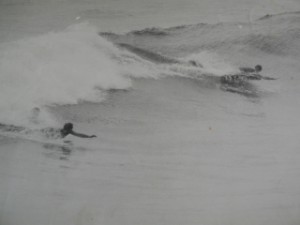
|
|
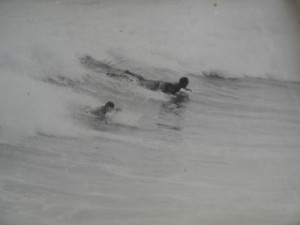
|
Photos
courtesy of Peter White. |
3. So you bought a paipo in
Hawaii?
I got Val Valentine,
who lived next to me in Sunset Beach, to make it for me. I haven't got
it now -- it died.
Peter with a Valentine Paipo Nui at Whatakane.
|
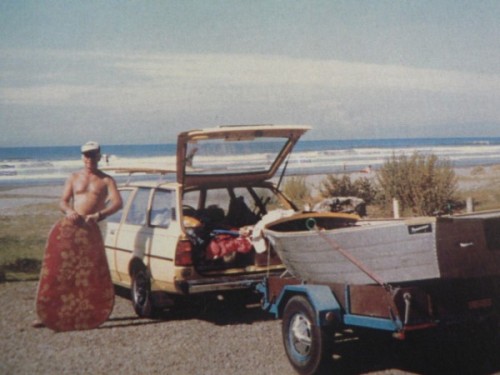
|
Photos
courtesy of Peter White. |
How long were you in Hawaii?
Three months.
Where did you surf in Hawaii?
Everywhere. Pupukea, Haleiwa, Sunset, Pipeline.
Where was your favorite with the paipo?
Pipeline was very good. There were four of us and about six Yanks
who were in the Army. They had a house right outside Pipeline. And that
was the crowd. Same as the old days at Mount Manganuii when we were
surfing with the boards. You knew everyone out there.
Did you see other paipos in Hawaii?
No, there weren't many.
Where did you see one being ridden that made you want
one?
Sunset probably. We used to watch it. That's also where we had our
quonset, right on the beach. It was quite overpowering to see those big
waves for the first time.
4. So all the other paipos I
have seen,
Mike Lawson's, Tony Butt's and Red Luton's board in the Muriwai surf
club were made by you?
I made the same sort
of board as Val Valentine. They are not as good as Val made.
Peter with one of his boards.
|
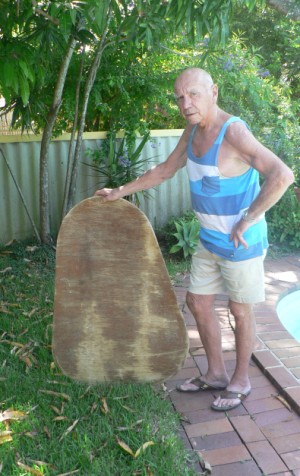
|
Photo courtesy of Peter White.
|
Mike Lawson's
paipo made by Peter.
|
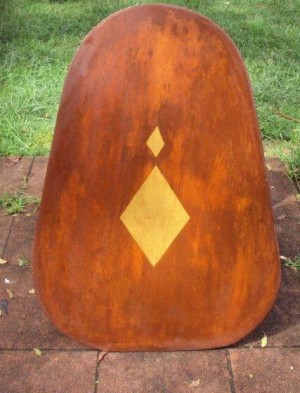
|
|
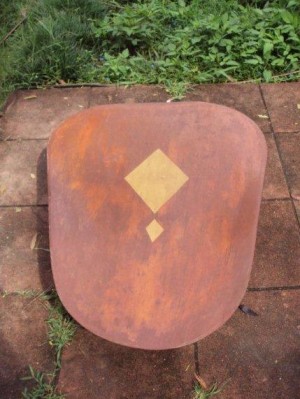
|
Photos
courtesy of Mike Lawson.
|
Mike Lawson's
paipo profile view and looking down to tail.
|
|


|
Photos
courtesy of Mike Lawson.
How long did you make them for?
A couple of years.
How many did you make?
I can't remember exactly but I made quite a few.
Who bought them?
The other blokes in the surf club to be quite honest.
Through word of mouth.
They saw how they worked.
So they were mostly Muriwai locals?
Yeah, they were really, but I've seen a lot more people around Tauranga
and everywhere. I don't know who they bought them off but they were
ones I made.
5. How did you make the
boards? Val used a concrete mould.
With a press carved
out of wood.
You used a wooden mould and a press. They weren't
steamed.
No, that's why a lot of them have a warped bottom on them. They were
actually made out of three layers of marine ply. I think it was three
layers of marine ply sheets. You cut them roughly to the shape you
wanted and you then used marine glue to join them together and put them
in the mould and packed them down. They were shaped like a heart. The
idea of the wood is that they ducked down but still floated beside you.
I got a hunk of wood and shaped it roughly with curved edges all around
it. The board was made a bit bigger and you clamped it down, all
around. When you release the clamps it had the curve in it.
So the mould was about half way up the board?
Yes, that's right. You put the edge on afterwards. You go around
with a file or something to get more uplift on the leading edge. I
think you need that edge. And then I smoothed it off where it was going
to be flat, so it stayed flat.
Really it's just a modern version of the old wooden boards that
they rode up here and you'd hire on the beach, with a curve in them.
Except they crippled you when you dug into the sand.
The tails are wider though?
That part of the tail is that holds you into the wave. Once you take
off and slide your body on it, the whole front of it comes out. If you
are going straight down a wave you have to pull yourself onto the back
of it or else you go straight.
How many clamps would you use?
About 10.
How long would you leave the clamps on?
At least for a couple of days. It had three layers of ply, all glued
with marine glue.
Were they finished in varnish?
No, they were finished with Hawaiian cloth, any type of cloth and
fiberglass on top.
Were they all the same size?
Val was making one for a pretty big Yankee guy. A young fella. He was
making a bigger one for his weight, not that weight had much to do with
it. At one stage I had a brother-in-law, he was only a little fella so I
made him a smaller one and it went all right. About a foot smaller so
he could carry it. You can make them any size you want to.
6. How long did you surf paipo boards?
I surfed them for
years and years. I've still got one with me.
Where did you surf your paipos?
I surfed them in New Zealand, and in Australia, too. Muriwai, but I surfed
all around New Zealand. Not much in Australia. Rainbow Bay was a good
wave but crowded. I was 45-years-old when I moved here. The Paipo Nui went faster
than a surfboard and you crack the wave before it even breaks.
Raglan is a fast wave - how did you surf it?
It's a point and there was a place to get down and we swam out
there from the rocks. I could take off closer into the rocks than the
surfboards were. You'd get a terrific ride in but it was a hell of a
swim back of course. The idea was to ride along the face of it. The
board was fast, so you'd pull your flippers down to slow down and dig
in your arm otherwise you'd run out of wave.
Would you do cut backs?
No, it was very hard to do them. There's no keel on them. You start
turning them and they get out of control. You can slow them down by
holding your hand in the water if you want to. You'd always use one
hand to hold up the leading edge and drag the other arm in the water.
You'd just do it automatically.
7. I was told that you worked
for Air New Zealand and that you picked up the board on one of your
trips.
That was a few years
later. In 1963, I went
there with a bloke called Jim Motel. He didn't have a paipo. There were
about five of us. Atlas Wood surfboards made us all surfboards. Then I
found the paipo. I'd use the board in the morning and the paipo in the
afternoon.
Jim Motel (top) and Peter surfing in Hawaii.
|
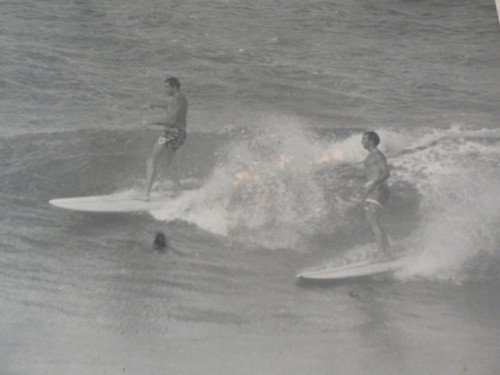
|
Photo
courtesy of Peter White. |
An interesting story.
It was a long time ago. I go out with a 30-foot motor on me now.
A well surfed
paipo - not a wall hanger
|
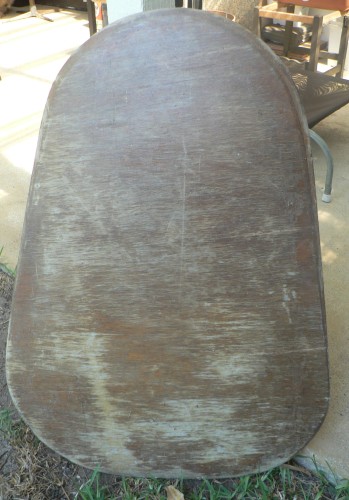
|
|
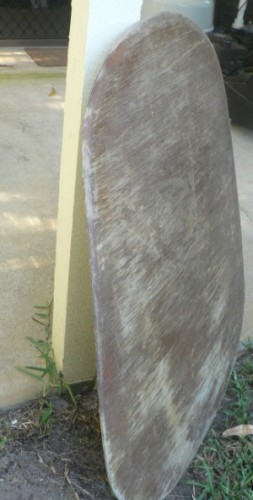
|
Photos
courtesy of Peter White. |
Other
info: See the related
paipo interview with Tony
Butt.
|
|












